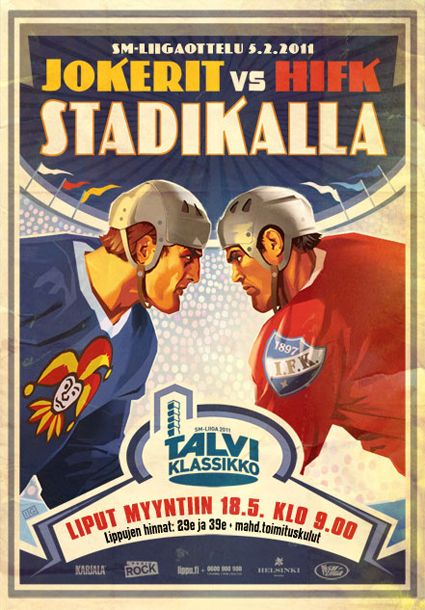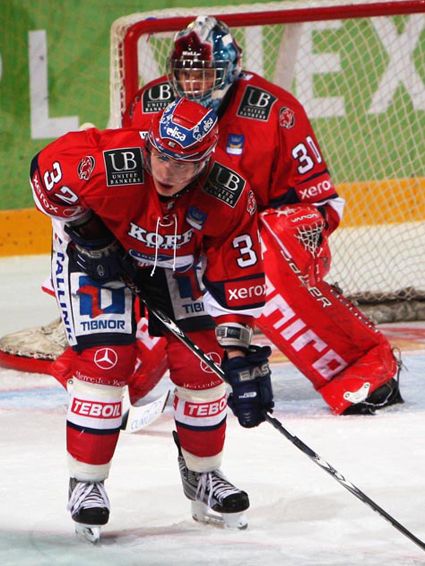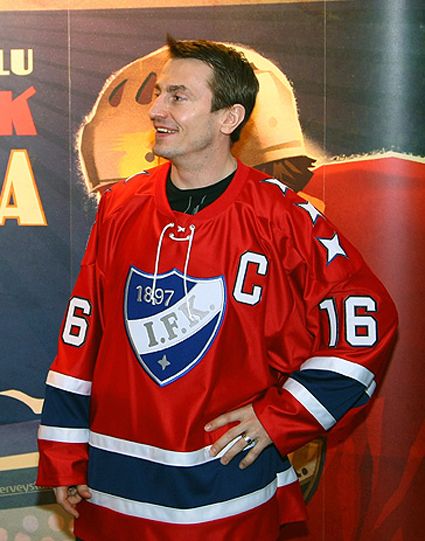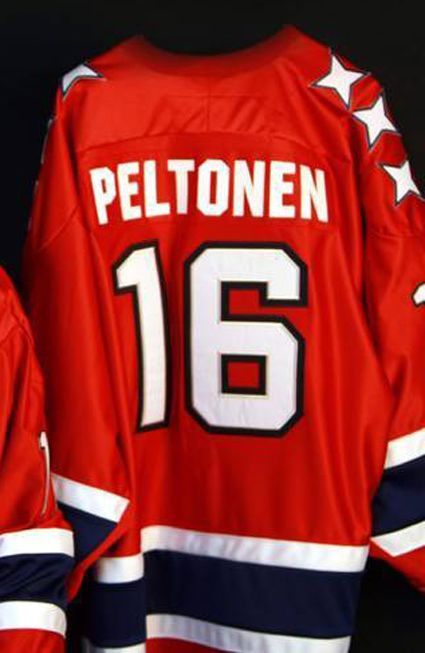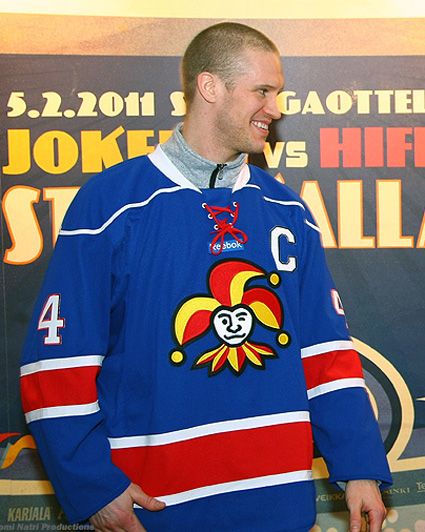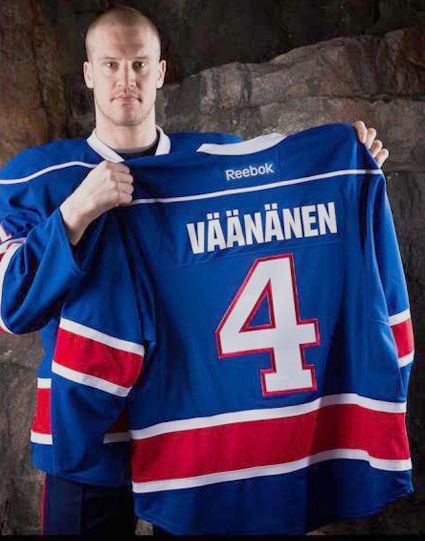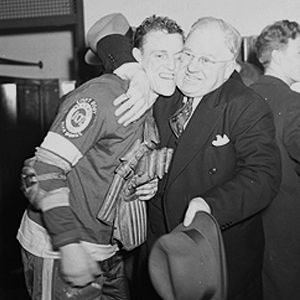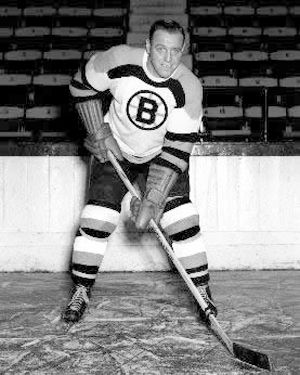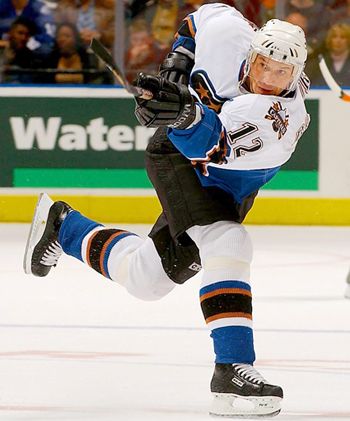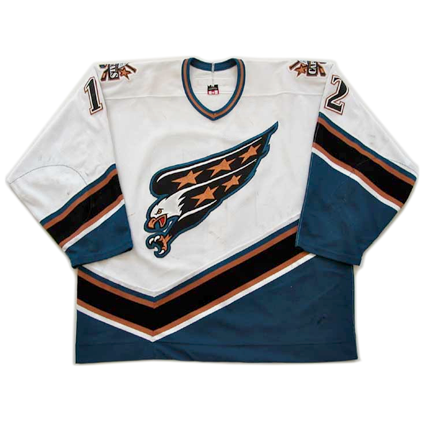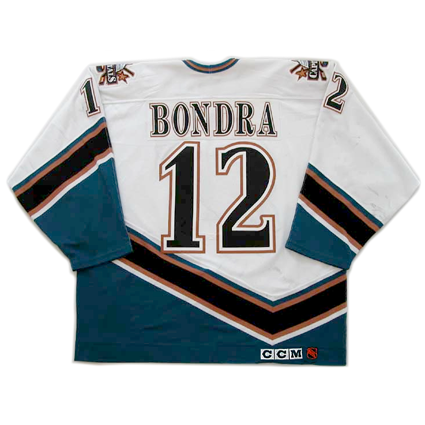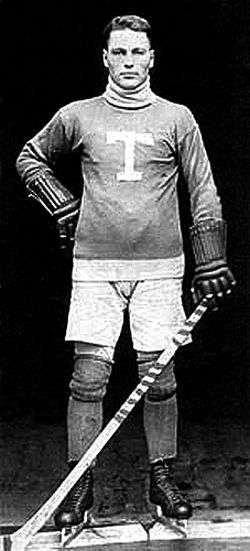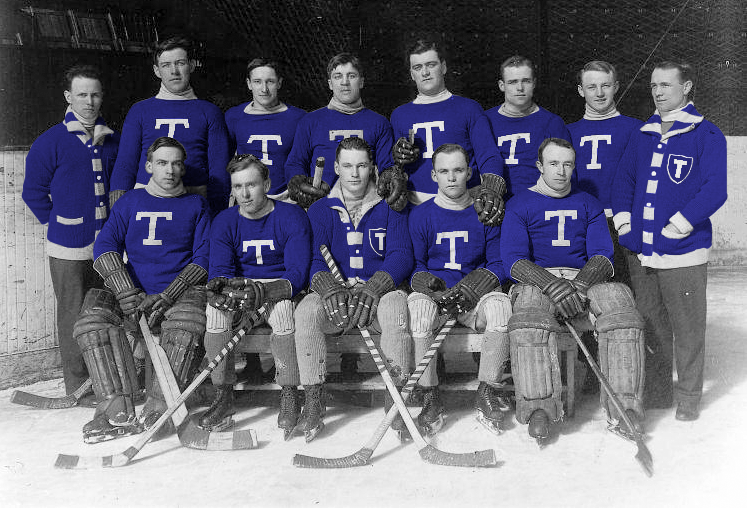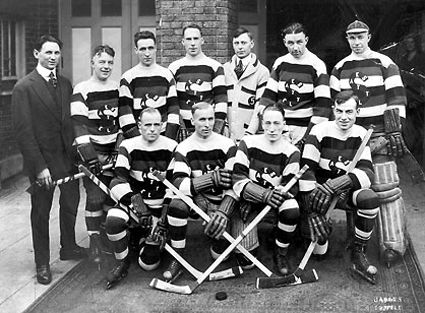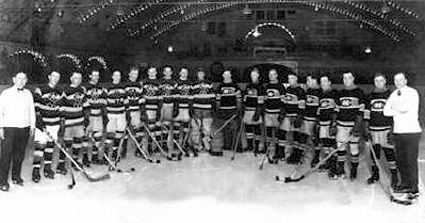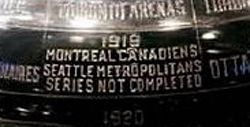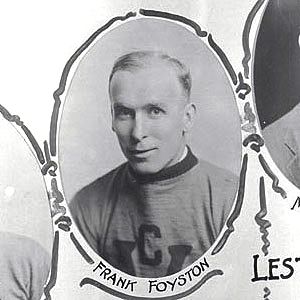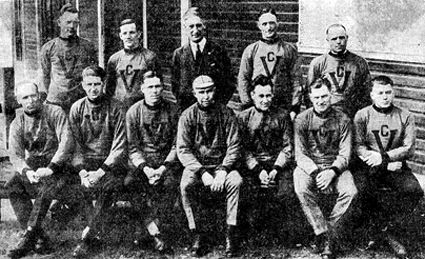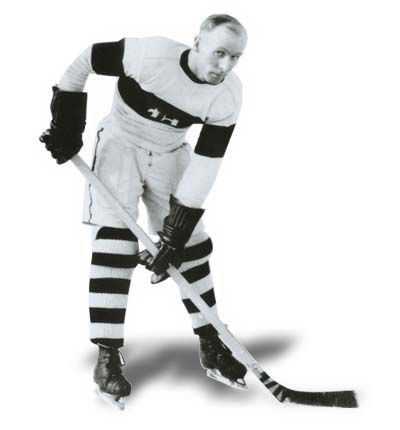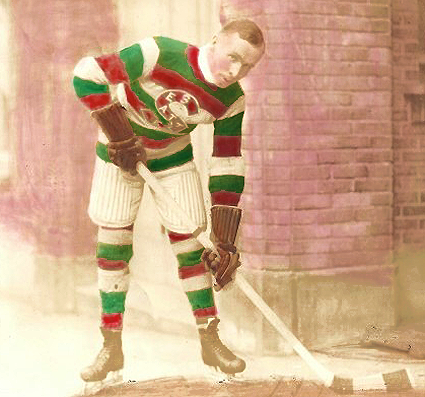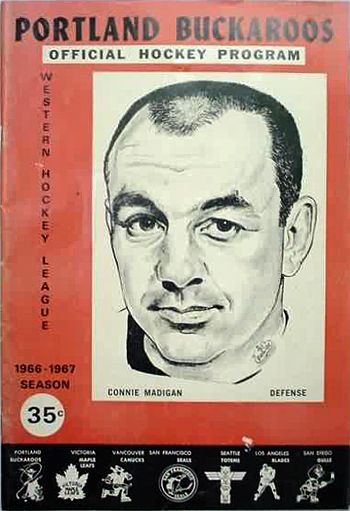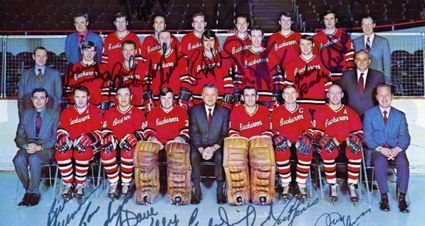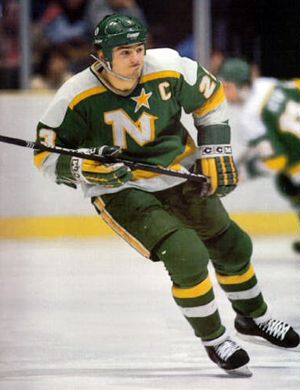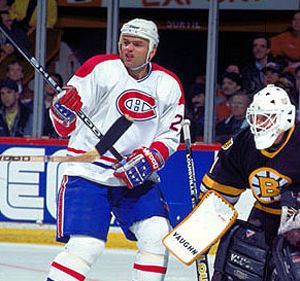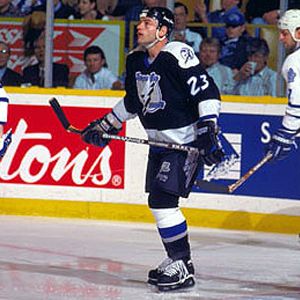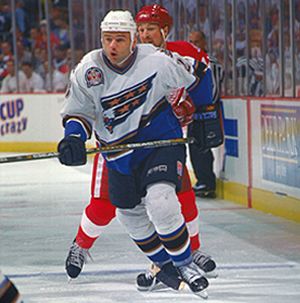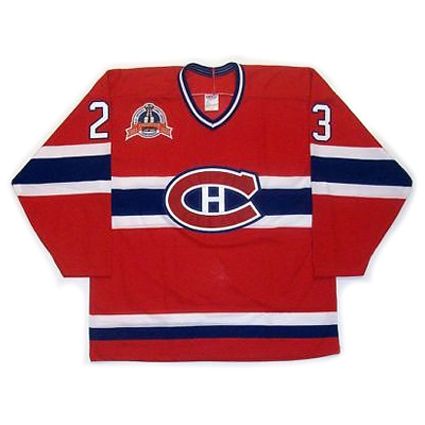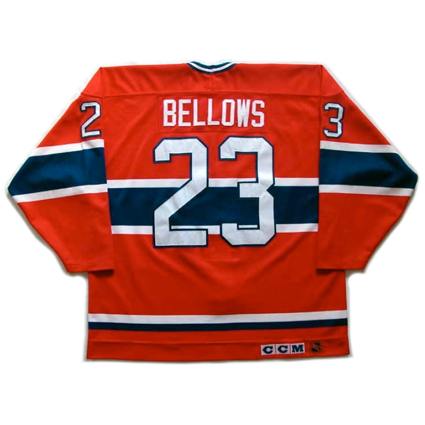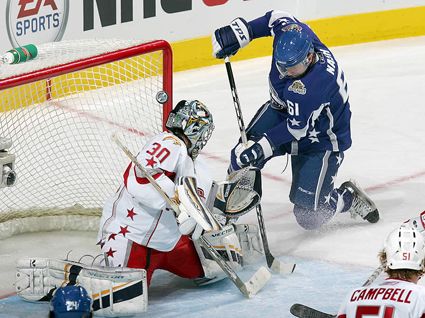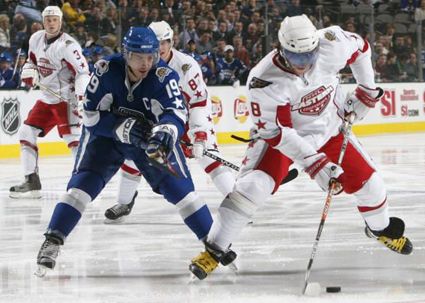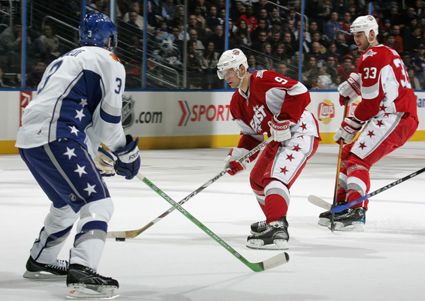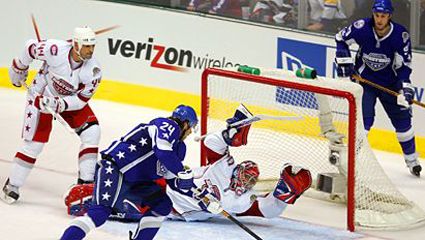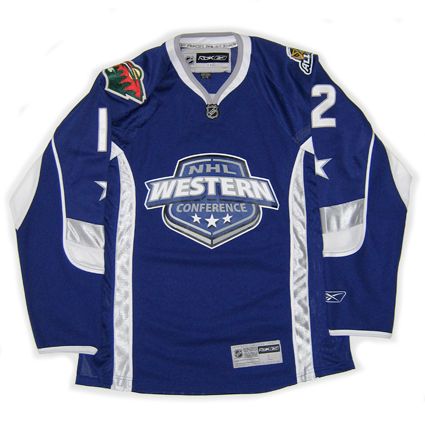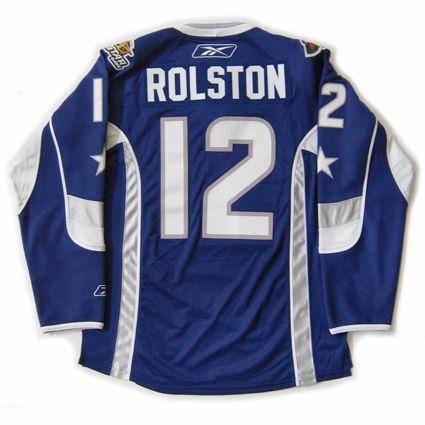Saturday, February 5, 2011
2010-11 HIFK Helsinki Ville Peltonen Jersey
The first ever Winter Classic (Talviklassiko) outdoor game to be held in Finland will take place today when Helsinki rivals Jokerit faces off against HIFK at the Olympic Stadium in Helsinki, the first hockey game held in the stadium since 1941, some 70 years ago!
Currently, HIFK is in third place in the SM-Liiga with 93 points, while Jokerit is in fourth place, albeit some distance behind at 79 points. Game time is 4:30 PM local time in Helsinki, which is 9:30 AM Eastern time in the United States, and temperatures are expected to be -3º C, or 26º F with a 15% chance of snow.
The game is a sell out, with 36,000 tickets having beens sold with each club's fans being seated on their own side of the stadium, which will certainly create a terrific atmosphere as well as setting a new record for attendance.
Recognizable names include Jokerit's team captain and former Coyote, Avalanche and Flyer Ossi Väänänen and HIFK's captain Ville Peltonen, who played in the NHL most recently with the Florida Panthers in 2009.
Both clubs will be wearing special throwback jerseys for the occasion, which are free from the usual plethora of advertisements found on jerseys in Finland.
A 2009-10 HIFK jersey with abundant sponsorship
A regular Jokerit jersey also replete with many sponsor logos
Today's featured jersey is a 2010-11 HIFK Helsinki Ville Peltonen jersey as will be worn in the first ever Finnish Winter Classic to be played in Helsinki's Olympic Stadium. This special throwback style jersey will be free from the overwhelming number of advertisements which normally appear on jerseys in Finland and have already proven enormously popular with the fans in Finland.
Bonus Jersey: Today's Bonus Jerseys is a 2010-11 Jokerit Helsinki Ossi Väänänen jersey that the Jokerit captain will wear in the Finnish Winter Classic.
The jerseys that will be worn in the game are already up for bid online and should be quite sought after by fans and collectors.
Here are additional videos in Finnish with Peltonen and Väänänen showing the unveiling of the jerseys to be worn.
UPDATE: Here is a highlight video of the game, attended by 36,644, showing the jerseys in action as well as some of the atmosphere surrounding the game, won by HIFK 4-3 on the strength of two goals in the opening minute of play.
Labels:
HIFK Helsinki,
Jokerit Helsinki,
Peltonen Ville,
Väänänen Ossi
Friday, February 4, 2011
1951-52 Boston Bruins Adam Brown Jersey
The second highest scoring player in NHL history born in Scotland, Adam Brown was born on this date in 1920 in Johnstone.
His family moved to Canada during his childhood and it was there he took up the game of hockey. He played senior hockey in the Ontario Hockey Association first with the Stratford Majors in 1938-39 and made his mark with the Guelph Indians in 1939-40 with 21 goals in 20 games.
He crossed the border to play of the Omaha Knights of the American Hockey Association in 1940-41 and the left winger made his NHL debut the following season with the Detroit Red Wings. He saw action in 28 games that season, scoring 6 goals and 9 assists for 15 points. He also played for the Indianapolis Capitals of the American Hockey League the other half of the season, where he averaged more than a point per game.
Brown spent the entire regular season with Indianapolis in 1942-43, but was called up by the Red Wings for the NHL post season. The Red Wings outlasted the Toronto Maple Leafs in six games and then swept the Boston Bruins in four straight to earn Brown his name on the Stanley Cup. During the playoffs he played in six of the Red Wings 10 games and contributed a goal and an assist.
Brown congratulated by Red Wings owner Jack Adams
Note the "Everybody Buy War Bonds" patch worn on the Red Wings sweaters during World War II in 1942-43 to 1944-45.
The next season Brown was a full time Red Wing, skating in 50 games where he scored a career high 24 goals as well as adding 18 assists for 42 points, good for sixth on the team.
Following that career year, Brown did not play professional hockey the following season at either the NHL or minor league level, owing to him performing military service due to World War II, but he did manage to play some senior hockey during his year away from the NHL.
Brown returned to the NHL in 1945-46 and picked up where he left off with a 20 goal season for Detroit which included a hat trick against Boston in the season opener. He returned to the Red Wings to begin the 1946-47 season, but after 22 games with Detroit, Brown was traded to the Chicago Black Hawks in early December. He played in 42 games for Chicago and scored 11 goals, falling just short of 20 for the season with a combined 19.
He was a member of the Black Hawks for five seasons in a defensive role before being involved in a trade that sent him to the Boston Bruins for the 1951-52 season. He split time between the Bruins (33 games) and Hershey Bears (30 games) of the AHL in what would prove to be his last NHL action.
He spent the entire 1952-53 season with Hershey and returned to Canada for the rest of his career. He played for the Quebec Aces in the Quebec Hockey League in 1953-54 and regained his scoring touch with 23 goals and 55 points, his highest point total in 11 years.
His final season playing hockey was spent in the Northern Ontario Hockey League with the Sudbury Wolves before he retired as a player. In ten NHL seasons, Brown totaled 104 goals and 113 assists for 217 points. It would take until 1991 for Steve Smith of the high scoring Edmonton Oilers to surpass Brown's status as the highest scoring NHL player from Scotland.
Sadly, Brown died in an auto accident just five years later at the age of 40.
His son Andy Brown later became a goaltender in both the NHL and WHA and was known as the last goaltender to play without a mask as late as 1977.
Today's featured jersey is a 1951-52 Boston Bruins Adam Brown jersey as worn during Brown's final NHL season. This attractive Bruins jersey was first used in 1949 and remained in use through 1955 and was the last Bruins jersey not to use the famous "spoked B" logo, which was introduced on the Bruins white home jerseys back in 1948.
Labels:
Boston Bruins,
Brown Adam
Thursday, February 3, 2011
1998-99 Washington Capitals Peter Bondra Jersey
It began like any other game when the Washington Capitals hosted the Tampa Bay Lightning on this date in 1999. Corey Schwab started in goal for the Lightning while the Capitals number one Olaf Kolzig took his familiar place in the crease for Washington.
14 of the 18 Capitals scored a point, led of course my Bondra's 5 points. Defensemen Johansson and Joe Reekie were both a +5. Conversely, every Tampa Bay player, save for Tucker who was even, finished the game with a minus rating with Wendel Clark and Chris Gratton getting tagged with a -4 for the game during which the last place Lightning were missing five defensemen due to injuries.
Washington failed to capitalize on a power play opportunity at 1:37 and the Lightning also could not score with their first man advantage at 8:17. Peter Bondra of the Capitals broke the stalemate at 10:40 shortly after Kelly Miller's charging penalty expired 23 seconds earlier. In fact, Miller received an assist on the goal. Despite two more power plays, Washington could not add to their lead and the period ended with the Capitals up by a goal and leading in shots by a comfortable 13-4 margin.
Peter Bondra
The well-travelled Mike Sillinger scored his fourth goal of the season from Rob Zamuner and Darcy Tucker at exactly 5:00 with both teams at even strength to tie the game at 1-1.
And then it began.
Bondra struck for the second time in the game at 9:46 to regain the lead for Washington and he completed his hat trick just 35 seconds later from Adam Oates. It was Bondra's 20th goal of the season, his eighth consecutive season of 20 goals or more.
Calle Johanson made it 4-1 for the Captials 1:29 later from Andrei Nikolishin and Brian Bellows 9th goal came just 35 seconds afterwards at 11:50 to stretch the Washington lead to 6-1. This marked the end of the line for Schawb in the Tampa Bay goal, and he was replaced by former Captial and NHL veteran Bill Ranford, who was rudely greeted by Joe Juneau's 10th goal of the season, from Bondra and Nikolishin just 1:15 after entering the game.
Bondra then confirmed the rout with his fourth of the game another 63 seconds afterwards from Oates and Juneau at 14:33.
James Black joined the scoring parade from Nikolishin, his third of the period, and Bellows at the 16:56 mark, the Capitals seventh even strength goal of the period.
Jaroslav Svejkovsky's third goal of the season, from Steve Konowalchuk and Jan Bulis came on the power play at 19:20 to give Washington eight goals in the second period alone and set a new NHL record for the fastest 8 goals by one team, which they did in 9 minutes and 34 seconds.
The period ended with Washington leading 9-1, with their 8 second period goals coming on 25 shots to Tampa Bay's 8. Once Bondra began the record scoring binge, the longest Washington went without a goal during the period was just 2 minutes and 24 seconds.
After the break, Washington set another record for the quickest 9 goals by one team in league history when Bellows 10th of the season, from Oates and Juneau, lit the lamp at 1:18 on the power play, giving the Capitals 9 goals in the span of 11:32.
The remainder of the game was scoreless as the Capitals cruised to a 10-1 final score and outshot Tampa Bay 46-22 for the game.
"Tonight was a night where we scored early and just kept going forward," said Bondra, who matched his goal total for the previous seven games. "I don't think I played bad before. I would hit a post. Tonight was a night when the puck went in. Everything I shot went in."
Today's featured jersey is a 1998-99 Washington Capitals Peter Bondra jersey as worn during his four goal performance during the Capitals record setting scoring binge against the Tampa Bay Lightning. While Bondra's four goal game was certainly impressive, it was not his best, as he once scored five goals in a game on February 5, 1994 in a 6-3 Washington victory over - the Tampa Bay Lightning.
The Capitals had adopted this style of jersey, often referred to as "the screaming eagle" style in 1995 after 21 seasons wearing their original red, white and blue jerseys. This style remained in use through the 2006-07 season before a complete redesign in 2007 coinciding with the new Reebok Edge jerseys saw a return to patriotic red, white and blue colors.
Labels:
Bondra Peter,
Washington Capitals
Wednesday, February 2, 2011
1916-17 Seattle Metropolitans Frank Foyston Jersey
Early hockey pioneer Frank Foyston was born on this date in 1891. He played 16 seasons as a professional beginning with the Toronto Blueshirts of the National Hockey Association (NHA) in 1912. He played center, rover and wing and was a renowned goal scorer.
Frank Foyston of the Toronto Blueshirts
In just his first season as a professional, Foyston scored 8 goals in 16 games with the Blueshirts. Now settled in as a Blueshirts regular, he scored 16 goals and 2 assists for 18 points in 19 games. The Blueshirts tied the Montreal Canadiens atop the NHA standings so a two-game, total-goals series was staged to determine the NHA championship.
Montreal won Game 1 with a 2-0 shutout by legendary goaltender Georges Vezina, but the Blueshirts came back to win the vital Game 2 by a score of 6-0 to win not only the O'Brien Cup as NHA champions, but become the holders of the prestigious Stanley Cup.
1914 Stanley Cup champion Toronto Blueshirts
The Blueshirts then defended their newly won Stanley Cup just three days later when challenged by the Victoria Aristocrats of the Pacific Coast Hockey Association (PCHA) in a best-of-five series held in Toronto. Toronto dispatched their western challengers in three straight games to retain the cup.
Foyston played one more season with the Blueshirts, scoring 22 points in 20 games before signing to play with the brand new Seattle Metropolitans of the PCHA for the 1915-16 season. Foyston made is presence in the PCHA known with nine goals and 13points in 18 games, but really became a force in the league the following season with 36 goals and 12 assists for 48 points in a 24 game schedule, good for third overall in league scoring. He also amassed 51 minutes in penalties, more than double the second highest total of his entire career.
The Seattle Metropolitans
As PCHA champions, the Metropolitans were paired with the NHA champion Montreal Canadiens in a best-of-five series. Montreal dominated Game 1 by a score of 8-4 but the host Metropolitans roared back to win three straight in dominating fashion, 6-1, 4-1 and 9-1 to became the first team based in the United States to ever win the Stanley Cup. During the four games of the finals, Foyston contributed 7 goals and 3 assists for 10 points.
The 1917 Stanley Cup finalists, the Seattle Metropolitans and Montreal Canadiens
The Metropolitans repeated as PCHA champions in 1919 and once more were facing the Canadiens when the remainder of the finals were cancelled with the teams tied at two wins each, along with a tie, when an outbreak of Spanish Influenza sidelined the Canadiens and eventually claimed the life of Joe Hall. Prior to the series being suspended, Foyston had done his part for the Metropolitans with nine goals in the five games.
Foyston again topped a goal per game in 1919-20 with 26 goals in 23 games. His 30 total points were the second most in the league. Seattle met their rivals, the Vancouver Millionaires, in the playoffs for the third consecutive season, with the Millionaires prevailing to advance to the Stanley Cup Finals against the mighty Ottawa Senators of the NHA. Ottawa would eventually out last the Metropolitans three games to two but not before the prolific Foyston scored 6 goals in 5 games.
The 1919 Stanley Cup engraving
For the final four seasons of the PCHA, Foyston remained among the leading scorers in the league, and led Seattle in scoring in 1921, 1923 and 1924 with a best of 26 goals and 30 points in 1920-21, but the Metropolitans failed to solve the Millionaires, later known as the Maroons from 1922-23, in three separate playoff series during that time.
With the demise of both the PCHA and the Metropolitans, Foyston joined the Victoria Cougars of the Western Canada Hockey League (WCHL), later simplified to the Western Hockey League (WHL).
Foyston while with the Victoria Cougars
While Foyston's offensive numbers would never reach the same levels as before, the Cougars were a successful team, defeating both Saskatoon and Calgary in the WCHL playoffs in 1925 to advance to face the Canadiens in a best-of-five final. The Cougars won the third Stanley Cup of Foyston's career by scores of 5-2, 3-1, 2-4 and 6-1. It was the only time since the start of the National Hockey League in 1917 that a team from outside the NHL would win the cup and would make Foyston one of only ten players to ever with the cup with three different teams.
1925 Stanley Cup champion Victoria Cougars
Prior to the 1925-26 season, Foyston retired from hockey only to return in time to play 12 games with the Cougars prior to the playoffs. Once in the playoffs, the third place Cougars repeated their feat from the year before, this time defeating Saskatoon and then Edmonton to win the WHL championship and reach the finals. They fell short this time, losing to the Montreal Maroons three games to one.
The WHL folded after the season and the players from Victoria were purchased for a new NHL club located in Detroit, Michigan, where the club was named the Cougars in honor of the team that supplied their first roster.
Foyston wearing the original sweater of the Detroit Cougars
He played the 1926-27 season with the Cougars in the NHL and then split time between the Cougars and the minor league Detroit Olympics as a player/coach in 1927-28. He remained with the Olympics in 1928-29 and stayed with the team in 1929-30 when they became charter members of the new International Hockey League for the final season of his long and distinguished career.
Foyston was one of the first players to ever score 200 goals, with 242 total career goals, led the PCHA in goal scoring twice and added 37 more playoff goals on his way to three Stanley Cups. He was inducted into the Hockey Hall of Fame in 1958.
Today's featured jersey is a 1916-17 Seattle Metropolitans Frank Foyston jersey. The Metropolitans were the first team based in the United States to win the Stanley Cup. They were founded in 1915 and won five PCHA titles and one Stanley Cup before folding in 1924.
Their distinctive green, white and red barberpole jersey style is a classic from the early days of professional hockey.
Labels:
Foyston Frank,
Seattle Metropolitans
Tuesday, February 1, 2011
1973-74 Portland Buckaroos Connie Madigan Jersey
Connie Madigan's career began in his hometown Port Arthur Bruins of the Thunder Bay Junior Hockey League in the 1952-53 season. After three seasons with the Bruins, Madigan moved up to the senior level in 1955 with the Peniction Vees of the Ontario Senior Hockey League for two seasons.
Madigan, a defenseman, also played for the Nelson Maple Leafs of the Western International Hockey League in 1958-59 where he was named to the WIHL First All-Star Team after helping lead the Maple Leafs to the Allan Cup as the champions of Canadian Senior Hockey. He then joined the Fort Wayne Komets of the International Hockey League for the following season, where he established a personal high with 57 points in 66 games.
After a second season with the Komets of Fort Wayne, Madigan moved west to play for the conventionally spelled Comets of Spokane in the Western Hockey League for the 1961-62 and 1962-63 seasons. Eventually Madigan was traded to the Los Angeles Blades after an argument with his Spokane coach that included a threat to trade Madigan, to which he responded "go ahead." Within the hour Madigan was on his way to Los Angeles!
After one season in Los Angeles, he was traded across the country to the Providence Reds of the American Hockey League. He would play in just ten games for Providence to begin the 1964-65 season before once more being traded for cash to the Portland Buckaroos back in the familiar WHL.
It was with Portland that Madigan's nomadic hockey career, which had seen him criss-crossing the North American continent would finally find a place to call home. Madigan became a stalwart on the Buckaroos blueline for the next nine seasons, never playing less than 60 games a year.
His first season with Portland would be a successful one, as the Buckaroos captured their second Lester Patrick Cup in franchise history as champions of the WHL. 1966-67 saw Madigan record his second 50 point season as a professional with 51 points and be named to the WHL First All-Star Team for the first of four consecutive seasons. Additionally, he was named the recipient of the Hal Laycoe Cup as the WHL's Outstanding Defenseman.
1964-65 WHL champion Portland Buckaroos
In 1969-70 Madigan left Portland for a ten game stint with the Dallas Black Hawks of the Central Hockey League, the fifth league he had now played in since turning professional back in 1958.
Back with Portland for the majority of the season, Madigan still had enough time to surpass the 100 penalty minute mark, keeping alive the rugged defenseman's streak that now stretched to 14th seasons and would eventually reach 18 consecutive seasons.
1970-71 would see the Buckaroos capture another Lester Patrick Cup following a season in which Madigan would establish a career high with 67 points which came in 72 games.
1970-71 WHL champion Portland Buckaroos
Following a 56 point season in 1971-72, Madigan began the season with Portland as usual, but on the final day of 1971, the unthinkable happened - he was sold.
While Madigan being traded for cash was not that unusual, as it had happened a number of times earlier in his career, the unthinkable element was to whom he was sold. The St. Louis Blues of the National Hockey League.
So it came to be on this date in 1973 that Connie Madigan of the St. Louis Blues became the oldest rookie in NHL history when he made his debut in a 3-3 tie against the Montreal Canadiens at the age of 38 years old.
At the time of his debut, his coach Jean-Guy Talbot was only two years older than Madigan and some of his teammates had not even been born yet when his career began!
Filling in for a pair of injured Blues defensemen, Madigan played in 20 games for St. Louis, scoring three assists and seeing action in five playoff games.
That would be the extent of Madigan's NHL career, as the Blues would sell him to the San Diego Gulls of the WHL for the start of the 1973-74 season. After 39 games with the Gulls, he once again returned home to Portland when he was sold yet again in February of 1974. Back with the Buckaroos he finished out the regular season and one final playoff run in the spring of 1975 before closing out his career with ten games in 1974-75 at the age of 40.
At the time of his retirement, Madigan was second in penalty minutes in minor league history.
His retirement would not be his final time on skates however, as Madigan appeared as Ross "Mad Dog" Madison in the greatest hockey movie of all time, "Slap Shot" starring Paul Newman in 1977.
Ross "Mad Dog" Madison
Today's featured jersey is a 1973-74 Portland Buckaroos Connie Madigan jersey. The Buckaroos began play in 1960-61 and took the name of a previous franchise which played in Portland from 1928 to 1941.
The team had a smashing debut, winning the WHL title in it's very first season. They went on to capture two more championships in 1965 and 1971.
They remained in the WHL until it folded in 1974. The franchise lingered on for another two seasons in first a semi-professional league and then a new amateur league, which did not last a full season, bringing and end to the Buckaroos after 15 seasons.
Today's video segment begins with a feature on Madigan presented by the Portland Winter Hawks, who saluted the Buckaroos on March 14, 2009.
In a a real unexpected find, Madigan slugs it out in a brief clip with Real Lemieux of the Los Angeles Kings during Madigan's time in the NHL.
This next video feature on the Portland Buckaroos, has some classic footage that is really a joy to see, and it's followed by some former Buckaroos, including Madigan, talking about their time in Portland.
Labels:
Madigan Connie,
Portland Buckaroos
Monday, January 31, 2011
1992-93 Montreal Canadiens Brian Bellows Jersey
After a successful junior career, during which he scored 116 points in his rookie season with the Kitchener Rangers of the OHL, Brian Bellows was drafted second overall by Minnesota in 1982 after the North Stars made a trade to move up with selecting Bellows in mind. He would play ten seasons in Minnesota, making it to the Stanley Cup Finals once in 1991 and appear in three All-Star Games, 1984, 1988 and 1992. His best offensive season was in 1989-90, when he scored a career high 55 goals and 44 assists for 99 points. Additionally, Bellows would serve as the North Stars captain in 1984.
In 1992 he was traded to the Montreal Canadiens, where he would play three seasons and capture his only Stanley Cup in 1993.
The later years of his career would see him traded to the Tampa Bay Lightning in 1995, where he played in his 1,oooth game on this date in 1996, scoring an assist in the Lightning's 4-1 win over the Pittsburgh Penguins.
He was then traded to the Mighty Ducks of Anaheim early in the 1996-97 season and would play 62 games during his only season in California.
He began the 1997-98 season with the Capitals, only they were the Berlin Capitals of the German DEL. After 31 games in Germany, he signed as a free agent with the Washington Capitals back in the NHL, with whom he would return to the Stanley Cup Finals later that season.
During his second season in Washington, he would score his 1000th point, becoming the 54th player to reach that milestone.
Today's featured jersey is a 1992-93 Montreal Canadiens Brian Bellows jersey. Bellows won the only Stanley Cup of his career with Montreal after being traded by the North Stars.
This classic Canadiens jersey features the 1993 Stanley Cup Finals patch on the front as worn when the Canadiens defeated Wayne Gretzky and the Los Angeles Kings. The Canadiens version of the cup finals patch was in French, the only such time that the patch has been made in other than English, and the only time there was a different version for both teams, as the Kings wore an English version on their jerseys.
Our video section today features Bellows, not known as a fighter, involved in a scrap with the Winnipeg Jets Laurie Boschman.
Here is Bellows fighting none other than ESPN's own Barry Melrose!
Here is the final minute of the 1993 Stanley Cup Finals, the only Stanley Cup of Bellows' career.
Labels:
Bellows Brian,
Montreal Canadiens
Sunday, January 30, 2011
2007 NHL All-Star Game Brian Rolston Jersey
The 2007 NHL All-Star Game was a significant event for not only the NHL, but it's new jersey supplier Reebok, as their new Reebok Edge Uniform System made it's on-ice competition debut.
Touted for it's lighter weight and more aerodynamic properties, the Edge Uniform System was also designed to be much more form-fitting than the previous generation of jerseys and offer enhanced player performance and increase safety and protection while offering a more breathable, water repellant jersey with a greater range of motion.
Claims of a 14% reduction in weight, equivalent to the weight of a hockey puck based on changes to the traditional jerseys and socks, combined with 76% less moisture absorption by the new fabrics developed for the new jerseys were expected to allow the players to stay stronger and play faster.
The durability was also claimed to be almost twice as long as that of the previous generation.
Wind tunnel testing showed the new jerseys to have 9% less aerodynamic drag than before as well.
The process to introduce the new jerseys began in 2003. Concepts were presented to general manager and the player's union and then prototypes were created and tested before the project was approved in the summer of 2006 and on-ice tests were conducted during team practices at both the NHL and minor league level before the jerseys finally made their debut at the 2007 NHL All-Star Game in Dallas.
Following their debut at the 2007 NHL All-Star Game, the Reebok Edge jerseys became the official on-ice jerseys for all 30 NHL teams beginning with the 2007-08 NHL season, which resulted in an unprecedented redesign of every jersey for every team in the league.
Today's featured jersey is a 2007 NHL All-Star Game Brian Rolston jersey, the first of the Reebok Edge jerseys to see action in NHL competition.
There was a mid-season redesign of the jerseys, known as the "Edge 2.0" once they began regular season use in 2007-08 after player complaints that the jerseys repelled so much water that excessive sweat was collecting in their gloves during games. The solution was to create a new jersey which used material from the previous generation of jerseys to retain some of the sweat repelled by the new jerseys.
The authentic jerseys sold at the retail level to fans are known as the Reebok Edge Authentic, while the replica version is referred to as the Reebok Premier. Both the Edge and Premier versions of the new jerseys have had a tough time being accepted by collectors due to the new jerseys being much more prone to snagging when worn. Complaints also focused on the basic fit of the jerseys, especially when compared to the previous generation of jerseys, as the arms are cut considerably longer when compared to an older jersey of the same body width.
Confusion has reigned about how the jerseys are tagged for sizing, with many wondering if they used to purchase a size large, should they now select an extra large to maintain the same fit they are used to and prefer when buying a jersey that is said to be more "form fitting".
The Premier jerseys have also received some very valid criticism for their shoulder patches when used, as the designs are screen printed on to a rather brittle piece of fabric which is then applied to the jersey, rather than a higher quality embroidered patch found on the replica jerseys made by CCM, ProPlayer, Starter and Nike before them.
The factory customization of the Premier jerseys also suffers from the same inferior quality treatment, as any name or number in more than one color has the inner color printed on with fake stitch marks, rather than being two actual layers of twill sewn together. Many collectors, including us here at Third String Goalie, prefer when buying a Reebok Premier jersey to purchase a blank one and have it customized with with layers of fully sewn twill.
Another large strike against the Premier jerseys was, despite the cheaper, and frankly unacceptable, printed shoulder patches, the price of a blank jersey jumped from roughly $80 for a CCM 550 to $120 for a Reebok Premier during one of the worst economies of our lifetimes when many were finding themselves out of work. We personally did not feel that a 9% reduction in aerodynamic drag was worth a 50% price increase for what we felt was a worse fitting, more fragile and more cheaply made product despite all the technological advances for on ice use, which have no effect on your average fan sitting in the stands who is not sweating buckets full of moisture or in need of any increased safety features.
Today's video segment is highlights from the 2007 NHL All-Star Game, which was the debut of the new Reebok Edge Uniform System. Watch out for the sudden volume increase at 4:30!
Next is Reebok's introductory video for the Edge Uniform System, first in English and then again in French.
Labels:
NHL All-Star Game,
Reebok Edge Jerseys
Subscribe to:
Comments (Atom)

